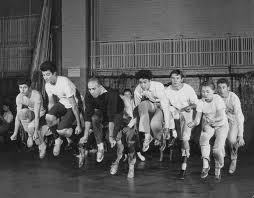
I am going to say it upfront; abuse me as you wish. In my humble but not entirely ill-informed opinion, West Side Story – with its story concept by William Shakespeare, “book” (play) by Arthur Laurents, lyrics by Stephen Sondheim, choreography and direction by Jerome Robbins, and music by Leonard Bernstein (1918-1990) – is very likely the greatest single work of musical theater thus far created in the United States. The story line, which deals with the confrontation of Hispanic and Anglo cultures on the streets of Manhattan, is as relevant today as it was when it opened at Broadway’s Winter Garden Theater on September 26, 1957. The story, play, lyrics and choreography of West Side Story are wonderful, but it is Bernstein’s remarkable music – jazzy and urban for the Anglos, characteristically Caribbean for the Puerto Ricans, and out-of-the-world heavenly for the lovers (Romeo and Juliet re-conceived as Tony and Maria) – that renders West Side Story the sublime masterwork that it is.
Bernstein was, by any measure, a superb composer, someone who was equally comfortable composing for the musical theater, the opera theater, the ballet theater, and the concert hall.

He also composed what is, to my mind, one of the most thrilling film scores of all time, the music for Elia Kazan’s brilliant On the Waterfront. (Released in 1954 and starring Marlon Brando, Rod Steiger, Eva-Marie Saint, Karl Malden, and Lee J. Cobb, On the Waterfront won 8 Academy Awards, including Best Picture. Bernstein’s score was nominated but did not win; Dmitri Tiomkin cadged the win with his score for The High and the Mighty. RIPOFF.)
Bernstein was a highly skilled pianist and he was an inspirational, crazy-charismatic conductor: the first native-born conductor to lead a major American orchestra and to gain international fame. As a pianist and as a conductor he fought the good fight and championed American music. In the 1950s he became one of the first Western conductors to champion the music of Dmitri Shostakovich, and he was single-handedly responsible for the Mahler revival of the 1960s that continues to this day. (He is buried in Brooklyn, New York’s Green-Wood Cemetery with the score of Mahler’s Symphony No. 5 placed across his heart.) …
Continue Reading, and see Dr. Bob’s Prescribed recording of Symphonic Dances from West Side Story, only on Patreon!
